

In 2021, over 159 billion packages were sent worldwide, and those numbers are to grow by 10% each year. Mailers and boxes are both excellent choices when it comes to shipping products – they are very reliable and affordable. However, they have different strengths and limitations, which means one may work better than the other in a specific situation. If you want to find out which one is best for your business and products, this article will help you make the right choice.

Source: Parcel shipping volume worldwide | Statista
In 2021, the volume of worldwide shipping in 13 major markets reached 159 billion parcels, which represents a new world record increase of 21% YOY. The global parcel revenue increased by 17% to over $491bn. (See: Global shipping volume to reach 200 billion parcels by 2025). Global parcel volume will most likely reach 256 billion by 2027, according to data released by Pitney Bowes Inc. That would represent an 8.5% cumulative annual growth rate from 2022-2027.
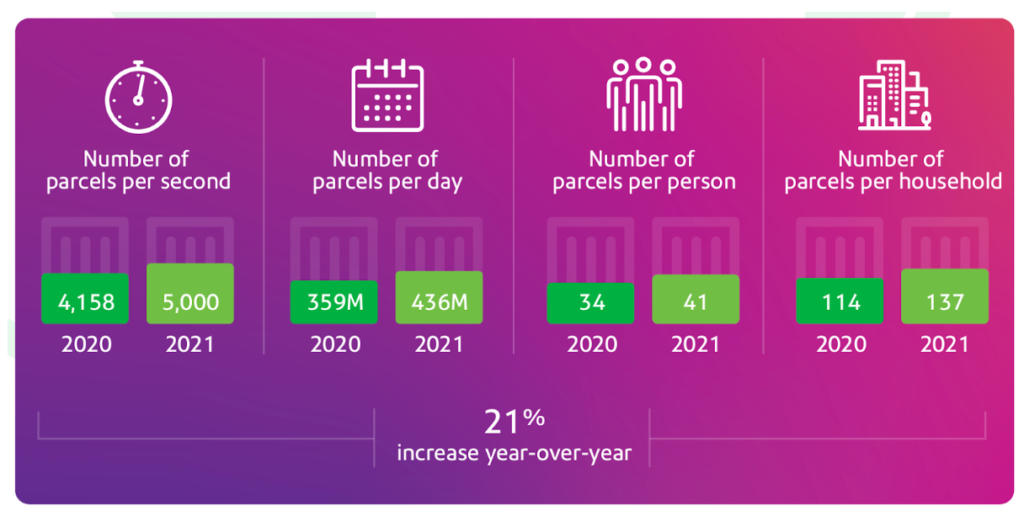
Source: Pitney Bowes Parcel Shipping Index
With such a large volume of shipments, the search for more sustainable packaging for shipping and more budget-friendly solutions is becoming crucial. With the current unstable situation on the market, many ecommerce companies are looking for ways to cut costs and, as it turns out, changing your packaging method can make a world of difference.
In 2020, the amount of packaging waste that was generated was estimated at 177.2 kg per inhabitant in the EU (varying from 66.0 kg in Croatia, to 225.8 kg in Germany). From 2009 to 2020, paper and cardboard were the main packaging waste material in the EU (32.7 million tonnes in 2020), followed by plastic (15.5 million tonnes) and glass (15.1 million tonnes).
When around 35 kg of plastic packaging waste is generated in the EU per capita, only close to 15 of it is recycled. This means that more than 40% still ends up in landfills or polluting our environment. (See: Ecommerce mailers: is recycled plastic a good choice?)
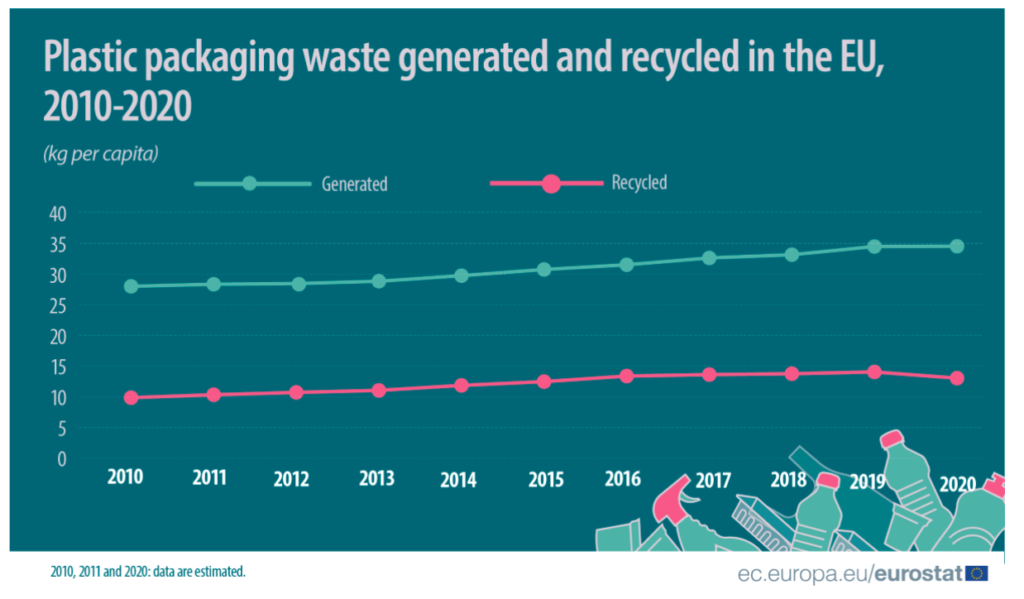
Over the last decade, a rising number of customers have become aware of the impact of their consumption on our environment and are now trying to lead a more sustainable lifestyle.
Many customers are drastically altering their buying habits at all levels, as we as a society become more conscious of environmental challenges. This extends to worrying about the shipping packing that their online items are delivered in!
In fact, a 2021 consumer survey from Trivium Packaging highlighted the fact that 57% of consumers are less likely to purchase products in environmentally hazardous packaging. In addition, 52% of them look for information on the recyclability or sustainability of the packaging! (See our other article: Shipping packages: what are consumers’ expectations in 2023 for ecommerce packaging?)
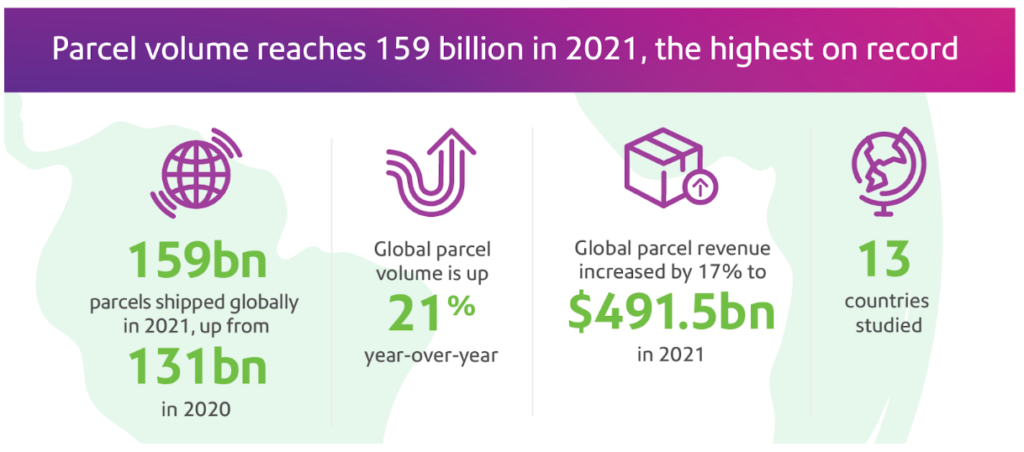
Source: Pitney Bowes Parcel Shipping Index
→ Poly mailers are best for non-fragile products
One of the most common eco-friendly ecommerce packaging practice is the use of poly mailers made of recycled plastic. These lightweight and inexpensive shipping bags are also known as plastic shipping bags, shipping mailers, or plastic mailing bags.
Poly mailers are self-closing, pliable polyethylene envelopes that work best for packing non-fragile products like clothing, footwear items, electronics, accessories, books, cosmetics, etc. (See: How to package clothes for shipping the cheapest way?) These shipping bags are small, affordable, lightweight, easy to seal and can be readily embellished with stamps and labels.
If composed of recycled materials, like our Co-Ex Filbags, they help save energy and resources that would have been used to produce virgin shipping packaging, and enable plastic waste to stay in the recycling loop.
Poly mailers made of recycled materials are thus the perfect option for ecommerce businesses looking for robust, high-quality, adaptable, and eco-friendly ecommerce packaging.
→ Use FSC-certified bubble mailers with recycled paper fibers for fragile items
Bubble padded envelopes are best for the safe shipment of small and medium-sized items. These shipping mailers are made of prime quality non-transparent paper and multi-layer LDPE bubble wrap that protect the parcel from damage and humidity. After its separation from the envelope, the wrap can undergo a recycling process.
Like any other paper or cardboard-based shipping packaging, you have to make sure that the pulp used during manufacturing comes from sustainable sources. That is why we recommend looking exclusively for FSC-certified bubble envelopes.
At FILMAR we produce high-quality bubble envelopes which are not only recyclable, and FSC-certified, but also made of 100% recycled fiber and 40% recycled plastic film. Choosing shipping packaging made of recycled materials is a guarantee that packaging waste stays in the recycling loop.
Bubble mailers made of recycled materials are the most cost-effective way to ship small, delicate objects such as fragile books, jewelry, and small electronic equipment.
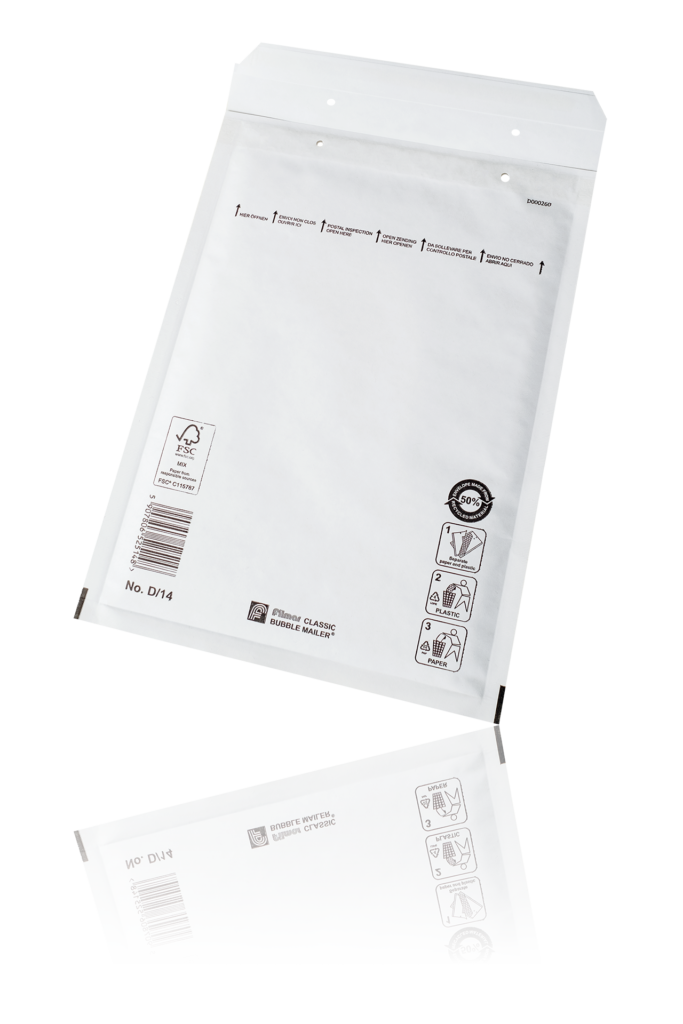
→ Low cost
Poly mailers made of recycled plastic are a low-cost and environmentally friendly way to package and ship products for online retailers (see: Ecommerce mailers: is recycled plastic a good choice?). They also help you save money and materials by reducing the need for void filling solutions in the parcel.
→ Productivity
Mailers boost production by reducing the need for labor. In contrast to other packaging materials, shipping mailers call for a two-step packaging procedure: packing the object and sealing it. This saves time and enhances volume output.
→ Moisture resistance
Shipping mailers can withstand water. Their resistance to moisture aids in preventing product deterioration.
→ Adhesive strength
Poly mailers come with a sturdy self-sealing adhesive. It helps to secure products during transit by ensuring nothing falls out. Some poly mailers are also tamper-resistant, which means that they cannot be opened and resealed without leaving some proof of it.
→ Compactness and lightweightness
Empty envelopes require less storage space because they are flat and lightweight. Additionally, they require less material to make and occupy less space during transport, so they cost less to ship! (See: Why use recycled shipping packaging?)
→ Eco-friendliness
Recycled plastic mailers are an eco-friendly budget product which is perfect for sending clothing or footwear items. These shipping bags are made from the best quality recycled materials and are fully recyclable after use. They have been recognized as an eco-friendly product by the Blue Angel environmental label that is awarded to particularly environmentally friendly products and services. (See: Poly mailer CO-EX FILBAG)
→ Air cushioning
The bubble padded envelopes will shield delicate goods from impact damage. They are therefore perfect for glass objects and other materials that are prone to breaking or scratching.
A great alternative to air-padded envelopes are foam envelopes. They are perfect for protecting delicate items such as CDs/DVDs, photos, albums, lacquered products and electronics.
→ Customized shipping bags with logo will help you build your brand image
Custom printed poly mailers can be branded to include statements, graphic elements, and colors. Customized shipping bags with logo are an excellent tool for building your brand image. Anyone who handles the product, like delivery couriers, postal employees, and your client, will notice a lovely, custom-made poly shipping bag.
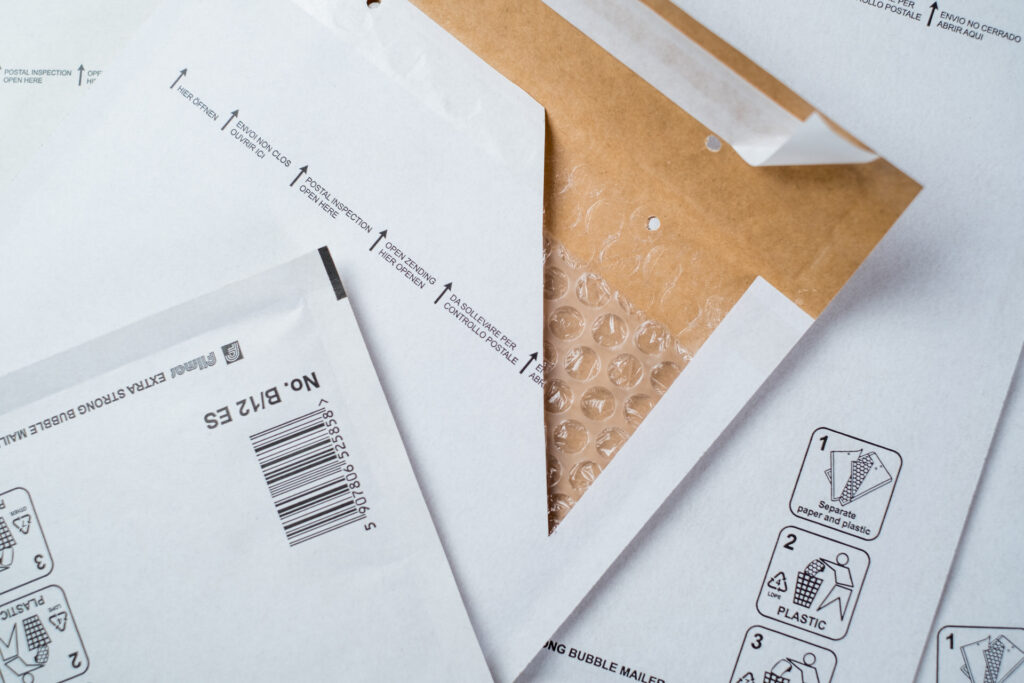
→ Shipping small items
Mailers allow you to ship products without additional packing materials, because there is almost no empty space to fill in comparison to shipping in a cardboard box. Mailers come in various sizes – standard and custom – and they are best for postal delivery. Paper mailers with bubble wrap are best for flat products that need protection against physical damage because they are lacquered or have screens (phones, tablets, etc.), while poly mailers are best for oddly shaped items such as clothing, footwear or electronics.
→ What size of mailer should I use?
It depends on your product whether you need a small or large shipping mailer. FILMAR offers Poly mailers in 9 standard sizes and 2 thickness variants. Customized sizes, branding solutions and special overprints are also available.
→ How many shipping mailers do I need?
Analyze your ordering patterns and do the math to ensure that you order enough shipping bags to last at least two months between orders. Although you don’t want to spend a lot up front, you want to retain enough inventory on hand. Look into getting a program that keeps track of all of your orders and inventory, and notifies you when you need more.
Corrugated boxes are made of rigid paper with several air columns inside. The columns give the paper more resilience compared to typical cardboard, and offer an air cushion for any objects inside. The ridges provide strength and flexibility.
Heavy paper pulp or thick paper stock are used to make cardboard cartons. Little containers, product packaging, structural support for less rigid things like notepads, inserts that prevent clothing items like button-up shirts from losing shape in their packaging, and other products are made from this material.
Cardboard containers can be used to ship goods, but doing so poses a danger to merchants because the material offers minimal protection and necessitates the use of additional materials, like bubble wrap, to guarantee the safety of the goods inside.
Instead of being constructed from a single sheet of material, corrugated boxes have multiple layers. The three layers consist of an internal liner, an exterior liner, and a fluted medium between the two. A crucial factor for companies who send a sizable quantity of goods is the durability and light weight of corrugated boxes. Even when exposed to shocks, wetness, and abrupt temperature fluctuations, these containers will not break.
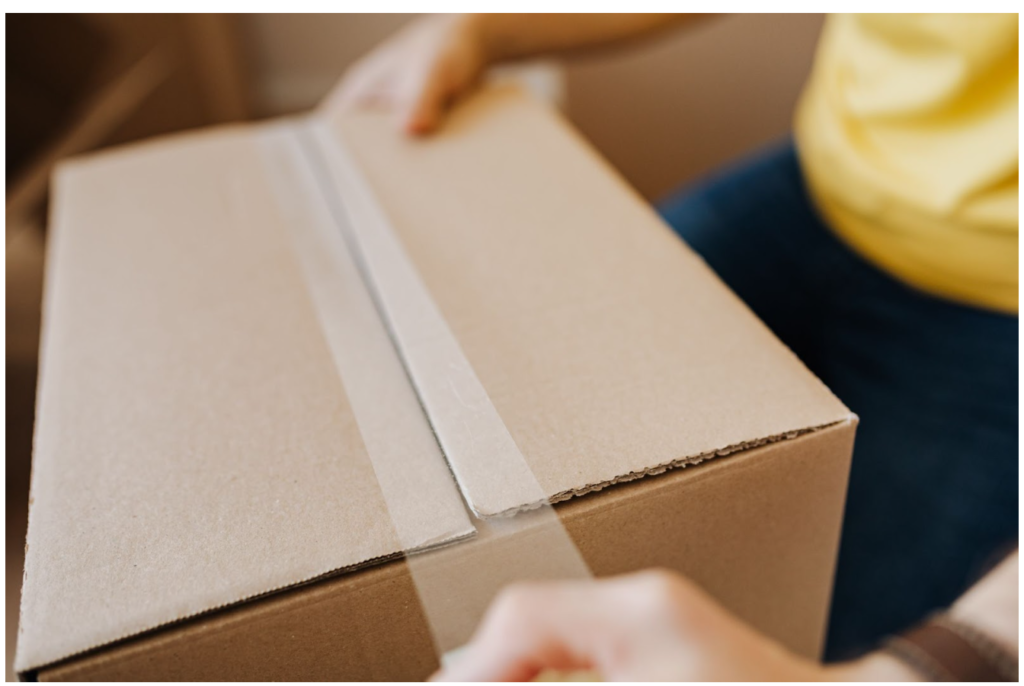
→ Strength
Compared to regular cardboard, corrugated boxes are more durable. For handling and transportation, they will provide every item they carry a strong padding. Additionally, they are made to keep moisture and germs from contaminating the things within, which is crucial for food items that must undergo protracted transportation durations.
On the other hand, corrugated boxes can be smashed down and damaged during handling and transport. Also, it is important with corrugated boxes to add filling (air pillows, bubble wrap) to make sure the items do not move in the parcel and will not absorb shocks.
→ Custom branding
To strengthen your brand and raise brand recognition, you can add branding statements to your corrugated packaging materials. However, the possibilities are limited in terms of colors and design because the colors on cardboard tend to come out less bright than on plastic or on paper.
Pre-printing and direct printing are the two primary techniques for printing on corrugated boxes. Printing directly onto the box is referred to as direct printing. The most typical method of printing on corrugated boxes is flexography or digital printing. Pre-printing is the process of initially printing on a piece of paper before adhering it to the corrugated box. Both methods are used depending on the company’s needs.
→ Eco-friendliness
We frequently make the mistake of believing that because cardboard boxes are composed of natural and biodegradable materials, we should choose them over bubble mailers and plastic shipping bags. Yet in practice, shipping packing made of cardboard and paper isn’t necessarily the most environmentally friendly choice for your company.
A recent survey found that 52% of all Europeans believe cardboard to be the most environmentally friendly shipping material. However, the Northern Ireland Assembly found that the production of plastic bags requires four times less water than that of paper bags (See: Ecommerce mailers: is recycled plastic a good choice?).
Not all paper products are eco-friendly by nature. When choosing a shipping packaging solution, it is important to look for products certified by the Forest Stewardship Council, which is an international non-profit organization that promotes responsible management of the world’s forests via timber certification. Only the FSC certification ensures that the pulp, paper and cardboard used in the packaging come from responsibly managed forests.
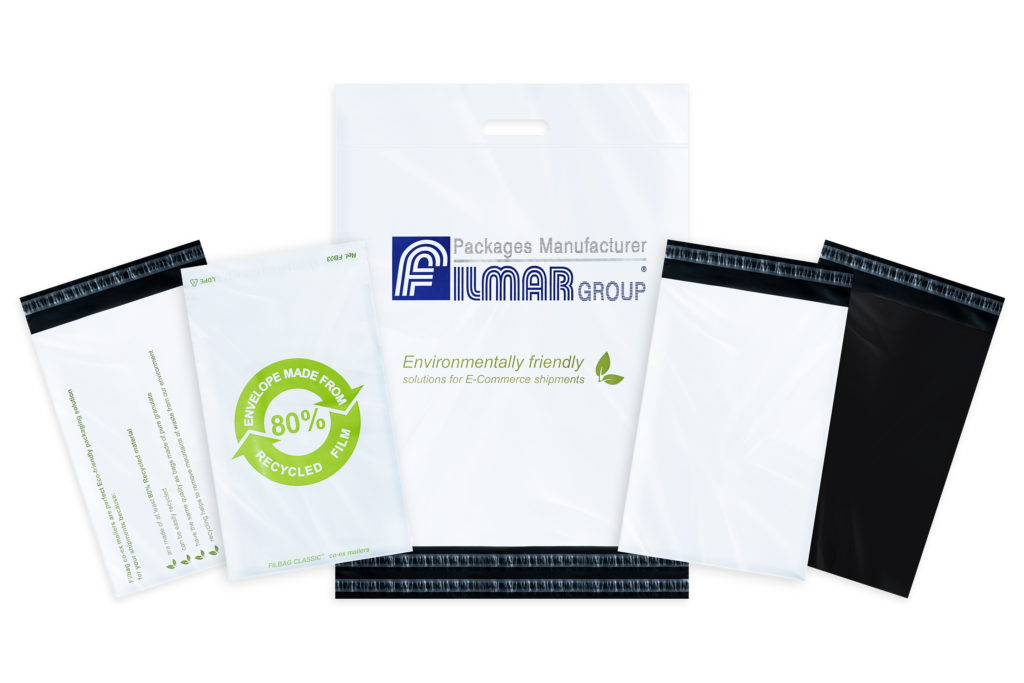
→ Shipping large items
You might have to use a shipping box for your products due to the weight limitations of mailers. Although weight affects transportation costs, protecting your goods is of utmost importance. Your shipping boxes must be built with more sturdiness, the heavier your products are. For heavy shipments, it is worthwhile to increase your budget in order to get the right design and materials. While transporting your goods, it’s critical to utilize the proper size box.
→ What size of boxes should I use?
Measure the item’s length and width on each side to estimate the size of the box you will need. Then double these sums by 2 after adding them all together (for a total of 4 measurements). You will then have the bare minimum internal measurements required for your shipper box.
→ How many boxes do I need?
You should always have enough boxes on hand to distribute merchandise to customers for two to three months. You might need to make an investment in storage if you don’t already have a place to keep the shipping boxes.
The materials needed are the primary distinction. Mail bags for shipping require far less paper and glue than corrugated boxes. If they offer sufficient protection, plastic shipping bags are a more eco-friendly ecommerce packaging option than corrugated boxes. (See: Ecommerce mailers: is recycled plastic a good choice?)
The choice of a packaging solution has an impact on postal costs as well; whether it is a domestic or an international package shipping, corrugated packaging will cost you more to mail than custom shipping bags of a comparable size.
If you are looking for the most eco-friendly ecommerce packaging solution that allows you to easily pack most items and guarantees low cost, then the choice is simple – mailers are the way to go. Poly mailers and bubble mailers reduce dimensional weight for shipments and waste potential, improve throughput and reduce carbon footprint.
Discover our ecological poly mailers now:
Check our FSC-certified bubble mailers:
